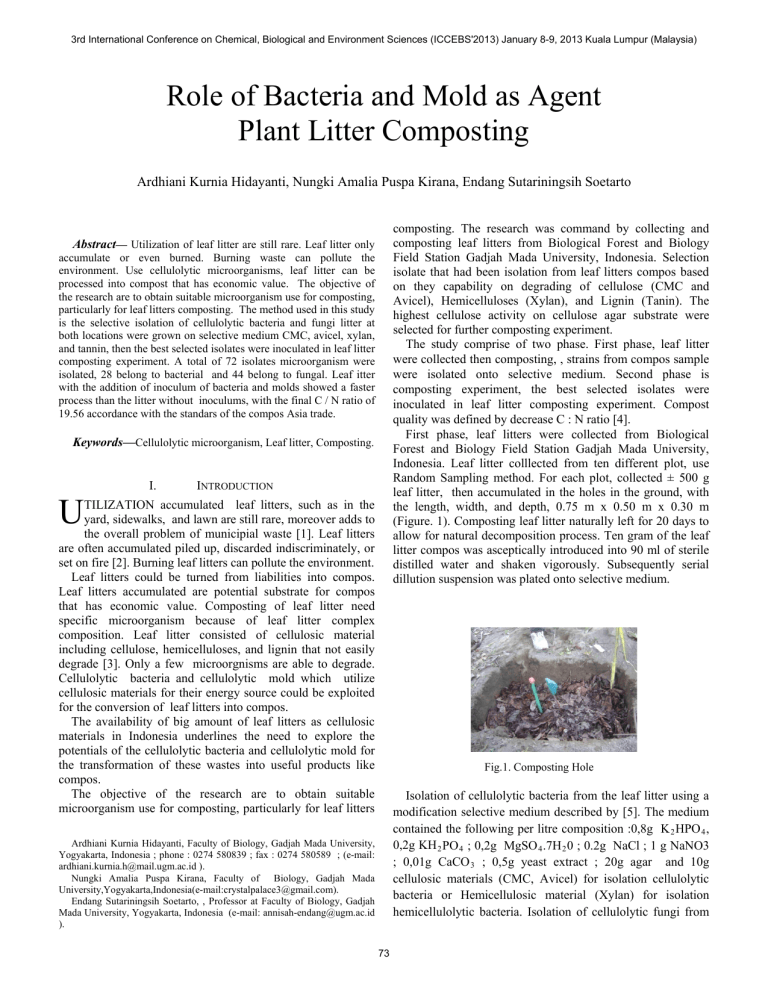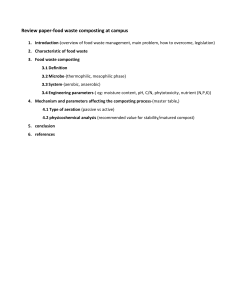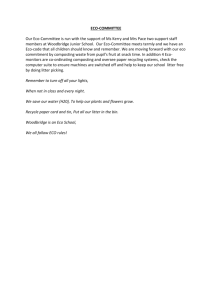
3rd International Conference on Chemical, Biological and Environment Sciences (ICCEBS'2013) January 8-9, 2013 Kuala Lumpur (Malaysia) Role of Bacteria and Mold as Agent Plant Litter Composting Ardhiani Kurnia Hidayanti, Nungki Amalia Puspa Kirana, Endang Sutariningsih Soetarto composting. The research was command by collecting and composting leaf litters from Biological Forest and Biology Field Station Gadjah Mada University, Indonesia. Selection isolate that had been isolation from leaf litters compos based on they capability on degrading of cellulose (CMC and Avicel), Hemicelluloses (Xylan), and Lignin (Tanin). The highest cellulose activity on cellulose agar substrate were selected for further composting experiment. The study comprise of two phase. First phase, leaf litter were collected then composting, , strains from compos sample were isolated onto selective medium. Second phase is composting experiment, the best selected isolates were inoculated in leaf litter composting experiment. Compost quality was defined by decrease C : N ratio [4]. First phase, leaf litters were collected from Biological Forest and Biology Field Station Gadjah Mada University, Indonesia. Leaf litter colllected from ten different plot, use Random Sampling method. For each plot, collected ± 500 g leaf litter, then accumulated in the holes in the ground, with the length, width, and depth, 0.75 m x 0.50 m x 0.30 m (Figure. 1). Composting leaf litter naturally left for 20 days to allow for natural decomposition process. Ten gram of the leaf litter compos was asceptically introduced into 90 ml of sterile distilled water and shaken vigorously. Subsequently serial dillution suspension was plated onto selective medium. Abstract— Utilization of leaf litter are still rare. Leaf litter only accumulate or even burned. Burning waste can pollute the environment. Use cellulolytic microorganisms, leaf litter can be processed into compost that has economic value. The objective of the research are to obtain suitable microorganism use for composting, particularly for leaf litters composting. The method used in this study is the selective isolation of cellulolytic bacteria and fungi litter at both locations were grown on selective medium CMC, avicel, xylan, and tannin, then the best selected isolates were inoculated in leaf litter composting experiment. A total of 72 isolates microorganism were isolated, 28 belong to bacterial and 44 belong to fungal. Leaf itter with the addition of inoculum of bacteria and molds showed a faster process than the litter without inoculums, with the final C / N ratio of 19.56 accordance with the standars of the compos Asia trade. Keywords—Cellulolytic microorganism, Leaf litter, Composting. I. INTRODUCTION U TILIZATION accumulated leaf litters, such as in the yard, sidewalks, and lawn are still rare, moreover adds to the overall problem of municipial waste [1]. Leaf litters are often accumulated piled up, discarded indiscriminately, or set on fire [2]. Burning leaf litters can pollute the environment. Leaf litters could be turned from liabilities into compos. Leaf litters accumulated are potential substrate for compos that has economic value. Composting of leaf litter need specific microorganism because of leaf litter complex composition. Leaf litter consisted of cellulosic material including cellulose, hemicelluloses, and lignin that not easily degrade [3]. Only a few microorgnisms are able to degrade. Cellulolytic bacteria and cellulolytic mold which utilize cellulosic materials for their energy source could be exploited for the conversion of leaf litters into compos. The availability of big amount of leaf litters as cellulosic materials in Indonesia underlines the need to explore the potentials of the cellulolytic bacteria and cellulolytic mold for the transformation of these wastes into useful products like compos. The objective of the research are to obtain suitable microorganism use for composting, particularly for leaf litters Fig.1. Composting Hole Isolation of cellulolytic bacteria from the leaf litter using a modification selective medium described by [5]. The medium contained the following per litre composition :0,8g K 2 HPO 4 , 0,2g KH 2 PO 4 ; 0,2g MgSO 4 .7H 2 0 ; 0.2g NaCl ; 1 g NaNO3 ; 0,01g CaCO 3 ; 0,5g yeast extract ; 20g agar and 10g cellulosic materials (CMC, Avicel) for isolation cellulolytic bacteria or Hemicellulosic material (Xylan) for isolation hemicellulolytic bacteria. Isolation of cellulolytic fungi from Ardhiani Kurnia Hidayanti, Faculty of Biology, Gadjah Mada University, Yogyakarta, Indonesia ; phone : 0274 580839 ; fax : 0274 580589 ; (e-mail: ardhiani.kurnia.h@mail.ugm.ac.id ). Nungki Amalia Puspa Kirana, Faculty of Biology, Gadjah Mada University,Yogyakarta,Indonesia(e-mail:crystalpalace3@gmail.com). Endang Sutariningsih Soetarto, , Professor at Faculty of Biology, Gadjah Mada University, Yogyakarta, Indonesia (e-mail: annisah-endang@ugm.ac.id ). 73 3rd International Conference on Chemical, Biological and Environment Sciences (ICCEBS'2013) January 8-9, 2013 Kuala Lumpur (Malaysia) the leaf litter using a modification selective medium described by [2]. The medium contained per litre : 2,13 g Na 2 HPO 4 ; 1,3 g KH 2 PO 4 ; 0,5g NH 4 Cl ; 0,2g MgSO 4 .7H 2 O ; 20g Agar ;10g cellulosic materials (CMC, Avicel) for isolation cellulolytic bacteria, Hemicellulosic material (Xylan) for isolation hemicellulolytic bacteria, and 5g lignin material (Tannin) [6]. Pure cultures of bacteria and mold were grown in selective medium CMC (Carboxil Methil Cellulose), Avicel and Xylan for test the ability of cellulose degradation. Then incubated for 2 days for bacteria and 7 days for mold in room temperature. Colonies that grew then washed with a solution of Congo red [7] for 10 minutes and rinsed with 1% NaCl. Visible colony growth from colony formation and the presence of a clear zone is the result of degradation of the CMC, Avicel and Xylan by isolate bacteria / mold. Cellulolysis was assessed by cellulolytic index by measuring the diameter of the clearing zone around the outside of colony [8]. Selected bacteria and mold which have the biggest cellulolytic index were characterization based on colony morphology, the morphology of cells, and the biochemical and physiological properties [9]-[10]. The date match observations using Bergey's Manual of Determinative Bacteriology. Identification of bacteria also using the BD Phoenix with 46 test kits based on biochemistry kit test. Identification of fungi carried by observing morphological characters both macroscopically and microscopically. Observed macroscopic characters include color and surface The data were identified using molds book [11]. Second phase, composting experiment with additional selected microorganisms. Leaf litter collected from each study site. Each treatment consisted of 2.5 kg leaf litter and was given additional source of N form bird dung and goat dung (1 :0,04) [12]. Control is leaf litters without inoculation of microorganisms, treatments were inoculated 1-2% inokulum [13]-[14], contain 105-106 CFU/ml. First treatments were inoculated with selected bacterial culture. Second treatment was inoculated with a culture of selected fungi. The third treatment was inoculated with selected bacterial and selected molds. Analysis of the C / N ratio was measured by determining total nitrogen (Kjehdal) and determination of organic matter (Walkey-Black) [15] and then determined the ratio of C / N compost by the formula: The ratio of C / N: Determination of Organic Materials Total Nitrogen Determination Analysis of levels of C / N, tested at the Soil Laboratory, Faculty of Agriculture, Gadjah Mada University. Fig. 2. Halozone around cellulolytic colony microorganism CAR 4B is the best cellulolytic bacterial isolate which has the bargest clearing zone and the biggest cellulolytic index 4.03±1.7 d. Cellulose in the medium induces the synthesis of cellulase by bacteria. When the medium in the vicinity of colonies of cellulolytic microorganism added reagents Congo Red, the area does not provide a solid red color but showed clear zone. Similarly, the bacterial isolates 48B XSS is the best xylanolytic bacteria with xylanolytic index 3.3±0.47 c. Mold isolates CK4 and AK51 are the best cellulolytic mold which has cellulolytic index 4,92 and 3,20. XK15 is the best xylanolytic mold with xylanolytic index 2,00, and TK70 is the best lignolytic mold which has lignolytic index 1,38 . Addition of inoculum in the litter accelerate the composting process. From the results of this study shows that the addition of inoculum microorganisms in the leaf litter showed a higher temperature when compared with the control without the addition of microorganisms. Initial temperature was 26 after two weeks of composting litter temperature increased with the addition of inoculum in the range 33-35 ° C. Temperature of 30-60 ° C is the optimum temperature during the composting process takes place [16]. After almost one month of composting, the temperature back down, indicating that the litter has become compost. pH during composting are in a neutral range from 6.5 to 7.5, it is in line with the opinion of [16] which states that the compost has a neutral pH. Humidity litter on days 0 composting by 36% after one month of composting, litter with the addition of inoculum microorganisms have the humidity above 50% humidity is common compost moisture, while the control without the addition of microorganisms, after one month of composting only have 29% humidity. Color composting litter after one month with the addition of inoculum showed differences when compared with the initial litter composting (Figure. 4.) . At the beginning of composting litter still green and yellowish brown, after the end of the composting color changes to dark brown. Changes in physical properties are the result of the decomposition process by microbes, it also proves that the composted material (grass) leaf chlorophyll loss (chlorophyll). It is also caused by microbial activity that produces CO 2 and water. Cellulolytic bacteria and fungi are microorganisms can break down cellulose in litter in to a simpler compounds [17]. The process begins with the colonization of litter decomposition by microorganisms such as bacteria and molds that can decompose leaf litter through enzymatic mechanisms. These microorganisms secrete enzymes that destroy molecules of complex organic molecules such as cellulose from leaf litter. Several enzymes are involved in the overhaul of organic materials such as cellulase and ligninase. A total of 72 isolates microorganism were isolated, 28 belong to bacterial and 44 belong to fungal.Cellulolytic bacterial and cellulolytic mold isolates showing clear zone around bacterial colonies (Figure 2.). Clear zone produced in the presence of the D-cellobiose and showed that cellulose in the medium has been hydrolyzed into simpler molecules by cellulase enzymes produced by microorganism [3] . 74 3rd International Conference on Chemical, Biological and Environment Sciences (ICCEBS'2013) January 8-9, 2013 Kuala Lumpur (Malaysia) C / N ratio is one indicator of compost maturity. Microorganisms break down the compound C as an energy source and using N for protein synthesis. During composting litter changes carbohydrates, cellulose, hemicellulose, fats and waxes into CO 2 and water, as well as changes in the protein to ammonia, CO 2 and water. This reduces the levels of carbohydrates which are compounds C and increase soluble N compounds in the form of ammonia, so the C / N ratio of litter dropped close ratio C / N soil. On day 0 composting, C / N ratio was 28.33, after composting for 36 days, a significant decrease in leaf litter with the addition of microorganisms (Figure 3). Natural composting process takes a relatively long time. In general, the composting process may take up to 8 week or 2-3 months even reached 6-12 months. But with the addition of inoculum microorganisms in this research, composting takes only 4-5 week. It is proved that microorganisms isolated from Biological Forest and Biology Field Station Gadjah Mada University, Indonesia, effective spur maturity litter into compost in a shorter time than controls and reduced the percentage of C / N ratio more quickly. Decline in the value of C / N ratio is due to the inoculation of microorganisms in the composting process and the microorganism will stimulate microbiological processes during composting progress. Fig. 3. C/N Ratio between varian treatment and control Fresh leaf litter had a C : N ratio of 28.33. After composting, the compos with bacterial inoculated gave a C : N ratio 20.43, reducing the C : N rat by 16.20 % relative to the starting material. The compos with mold inoculated gave a C : N ratio 21.79, reducing the C : N rat by 13.04 %. The compos with mold and bacterial inoculated produced an even lower C:N ratio of 19.56, a 18.31% reduction. The uninoculated treatment gave a C : N ratio of 26.45, not significant reducing the C : N rat by 3.43%. Compos with mold and bacterial inoculated showed the lowest C:N ratio, bacterial and mold enzymes act synergistically to catalyse the hydrolysis of cellulose [18] and more optimal activity in degrading compost. The results of the final C / N ratio of composting with the addition of mold and bacteria inoculums qualified accordance with the standars of the compos Asia trade defined by Food and Fertilizer Technology Center (FFTC),C / N ratio < 20. Plant litter is a source of carbon and nitrogen that can be a substrate for microorganisms living. Various microorganisms have the ability to decompose litter. Decomposition is the process of decomposition and separation of organic materials broken into sections. Decomposition of organic matter occurred in the composting process by the addition of inoculum of microorganisms and without the addition of inoculum of microorganisms, but with the addition of composting microorganisms inoculum compost maturation process accelerated by microorganisms. Microorganisms play an important role as an activator in the compost maturation process. Fig. 4. Comparative product leaf litter composting after fourth week Characterization and Identification of Selected Isolates based on morphology colony CAR 4B isolates of bacterial colonies grown on agar plate has a rhizoid shaped, the colony edges lacerate / ramose. These colonies creamy light brown and opaque. While XSS 48B isolate bacterial colonies grown on agar plate has a rhizoid shaped rhizoid, with lobate edge of the colony. These colonies are cream colored and opaque.Based on the morphology cell, bacterial isolates CAR 4B and 48B XSS are rod shape gram-positive bacteria. The results of the BD Phoenix identification based on 46 biochemical tests, showed that the CAR 4B isolates, isolated from the litter in the Biological Garden, has characteristics similar to Bacillus subtilis. While XSS 48B isolates were isolated from the litter in Biology Field Station, has characteristics similar to Bacillus subtilis. The results of mold characterization show that an isolate CK4 similar to Basidiomycetes, AK51 similar to Pennicillium, whereas isolates AK 15 and TK 70 similar to Aspergillus. ACKNOWLEDGMENTS The research was supported by IMHERE Grant Research, Faculty of Biology, Gadjah Mada University. 75 3rd International Conference on Chemical, Biological and Environment Sciences (ICCEBS'2013) January 8-9, 2013 Kuala Lumpur (Malaysia) REFERENCES [1] [2] [3] [4] [5] [6] [7] [8] [9] [10] [11] [12] [13] [14] [15] [16] [17] [18] [19] S. Gajalakshmi, E.V. Ramasamy, and S.A. Abbasi, “Composting Vermicomposting of Leaf Litter Ensuing from The Trees of Mango (Mangifera indica)”, Bioreseurce Technology 96, pp. 1057-1061, November 26. 2004 S.N. Chinedu, V.I. Okochi, H.A. Smith, and O. Omidji, “Isolation of Cellulolytic Microfungi Involved in Wood Waste Decomposition : Prospek for Enzymatic Hydrolysis of Cellulosic Wastes”, International Journal of Biomedical and Health Sciences, vol 1, no 2, September 30. 2005. D. Barman, Z.A. Saud, M.R. Habib, M.F. Islam,K. Hossain, and T.Yeasmin, “Isolation of Cellulolytic Bacterial Strains from Soilfor Effective and Efficient Bioconversion of Solid Waste”, Life Sciences and Medicine Research, (25), pp 1-10. July. 2011 T.D. Hart, D. Leij, G. Kinsey, J.Kelley, and J.M. Lynch, “ Strategies for the isolation of Cellulolytic Fungi for Composting of Wheat Straw”, World Journal of Microbiology and Biotechnology 18, pp. 471-480, February 28. 2002. J.M. Dickerman and T.J Starr, “A Medium For The Isolation of Pure Cultures of Cellulolytic Bacteria”, Journal of Bacteriology, American Society of Microbiology, 62 (1), p. 133. 1951. A. Wahyudi, M.N Cahyanto, M. Soejono, and Z. Bachruddin, “Potency of Lignocellilose Degrading Bacteria Isolated From Buffalo and Horse Gastrointestinal Tract and Elephant Dung For Feed Fiber Degradation”, Journal Indonesian Tropical Animal Agriculture. 35, pp 33-41, March 2010. W.S. Jo, S.H. Bae, S.Y. Choi, S.D Park, Y.B. Yoo, and S.C Park,”Development of Detection Methods for Cellulolytic Activity of Auricularia auriculajudae”, Mycobiology 38(1), pp. 74-77, 2010. A.K. Hidayanti, R.E. Nindyasari, A.N. Lathifah, W. A. Ramadaningrum, A. Ridhowati, F. B. Muhammad, A. Pramana, M. Dewi, Y.A. Purwestri, and Trijoko. “Isolation Bacteria and Characterization Cellulose Enzyme from Milkfish Gastrointestinal as Potential Agent to Degrade Cellulose”. Prosiding International Conference of Sustainable Agriculture and Food Safety. Padjajaran University. Bandung. 2011. L.Sembiring, Petunjuk Praktikum Sistematik Mikrobia. Laboratorium Mikrobiologi, F.Biologi UGM, Yogyakarta. 2008. E.S. Soetarto, S. J. Nastiti, T. Suharni, L. Sembiring. Petunjuk Praktikum Mikrobiologi. Laboratorium Mikrobiologi, F.Biologi UGM, Yogyakarta. 2009. D. Malloch, Moulds, Their Isolation, Cultivation and Identification. University of Toronto Press. London. pp 51-89. 1981 S. Sarkar, R. Banerjee, S. Chanda, P. Das, S. Ganguly, and S. Pal, “Effectivenes of Inoculation With Isolated Geobacillus Strain in The Thermophilic Stage of Vegetable Waste Composting”, Bioresource Technology, 101, pp. 2892-2895, 2001. G. Zayed and A. Motaal, “Bioproduction of Compost With Low pH and High Soluble Phosphorus From Sugar Cane Bagasse Enriched With Rock Phospate”, World Journal of Microbiology and Biotechnology 21, pp. 747-752, 2005. I. Ekawati, “Pengaruh Pemberian Inokulum Terhadap Kecepatan Pengomposan Jerami Padi”, Jurnal Tropika vol 11. 2003 K.L Sahrawat, “Simple Modification Of The Walkley-Black Method For Simultaneous Determination Of Organic Carbon and Potentially Mineralizable Nitrogen In Tropical Rice Soils”. Plant and Soil, 69,pp 73-77. 1982. E. Noor,M.S Rusli, M. Yani, A. Halim, dan N. Reza.”Pemanfaatan Sludge Limbah Kertas Untuk Pembuatan Kompos Dengan Metode Windrow dan Cina” Jurnal Teknik Industri Pertanian. Vol 15 (2),pp. 6771. 2006 M.V. Sizova, J. A. Izquierdo, N. S. Panikov and L. R. Lynd, “Celluloseand Xylan-Degrading Thermophilic Anaerobic Bacteria from Biocompost” .Applied Environmental Microbiolology, 77(7):2282. 2011. R. Kumar, S. Singh, and O.V. Singh, “Bioconversion of Lignocellulosic Biomass : Biochemical and Molecular Perspectives”, Journal Industrial Microbiology Biotechnology Springer 35, March 13,pp. 377-391, 2008. S. Widawati, “Daya pacu Aktivator Fungi Asal Kebun Biologi Wamena Terhadap Kematangan Hara Kompos”. Biodiversitas Vol 6, No 4, pp. 238-241. 2005. 76





